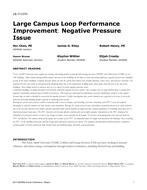
LB-17-C070 — Large Campus Loop Performance Improvement: Negative Pressure Issue
- Comments Off on LB-17-C070 — Large Campus Loop Performance Improvement: Negative Pressure Issue
- ASHRAE
Texas A&M University main campus has heating and cooling district to provide both heating hot water (HHW) and chilled water (CHW) to over 230 buildings. After commissioning utilities plants and some of the buildings on the loop to ensure operational efficiency, negative pressure was identified in four of the tallest buildings. Negative pressure allows air into the system that reduces heat transfer efficiency, causes noise, and increases corrosion. The negative pressure also results in consuming more pumping power due to the requirement of lifting water above plant static pressure to the top of the buildings. These things lead to an increase costs so it is critical to resolve negative pressure issues.
Commonly buildings exceeding the plant static pressure experience negative pressure, which is not a unique issue on large thermal loops as design firm engineers and facility personnel may overlook its occurrence. This study was initialized by performing a pressure distribution analysis on the campus thermal loop in order to identify the reason for the negative pressure. Further investigation into several solutions was required as the issue is not easily solved by increasing building pump’s capacity or balancing water system.
Raising the system static pressure, indirect connection with a heat exchanger, and installing a pressure sustaining valve (PSV) were all explored thoroughly as separate solutions by data analysis and simulation. Raising the system static pressure and indirect connection proved to be costly solutions due to the need for expensive new double capacity expansion tank and installation of higher pressure capacity equipment, or building renovations due to limited mechanical room space. The PSV proved to be the most effective solution after an in-depth analysis. Simulations of the PSV displayed the reliability of its pressure control as well as any changes in power, head, and flow in the pumps. No increase in pumping power was observed with the PSV installation. The control scheme of the pump and set point of the PSV are dependent upon the height and demand of the building. Also, installing the PSV on the building return pipe will not change plant operation and pressure control. The solutions and procedures outlined provide a beneficial technical guide or lessons learned for large thermal loop and building design, operation, and maintenance.
Citation: 2017 Annual Conference, Long Beach, CA, Conference Papers
Product Details
- Published:
- 2017
- Number of Pages:
- 8
- Units of Measure:
- Dual
- File Size:
- 1 file , 1.1 MB
- Product Code(s):
- D-LB-17-C070

